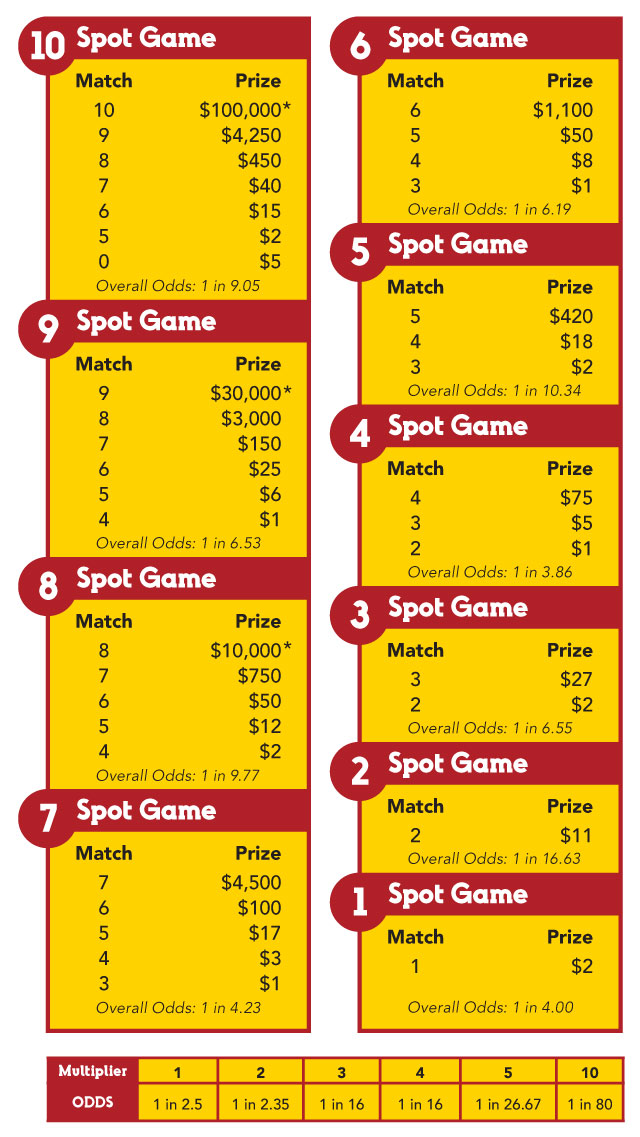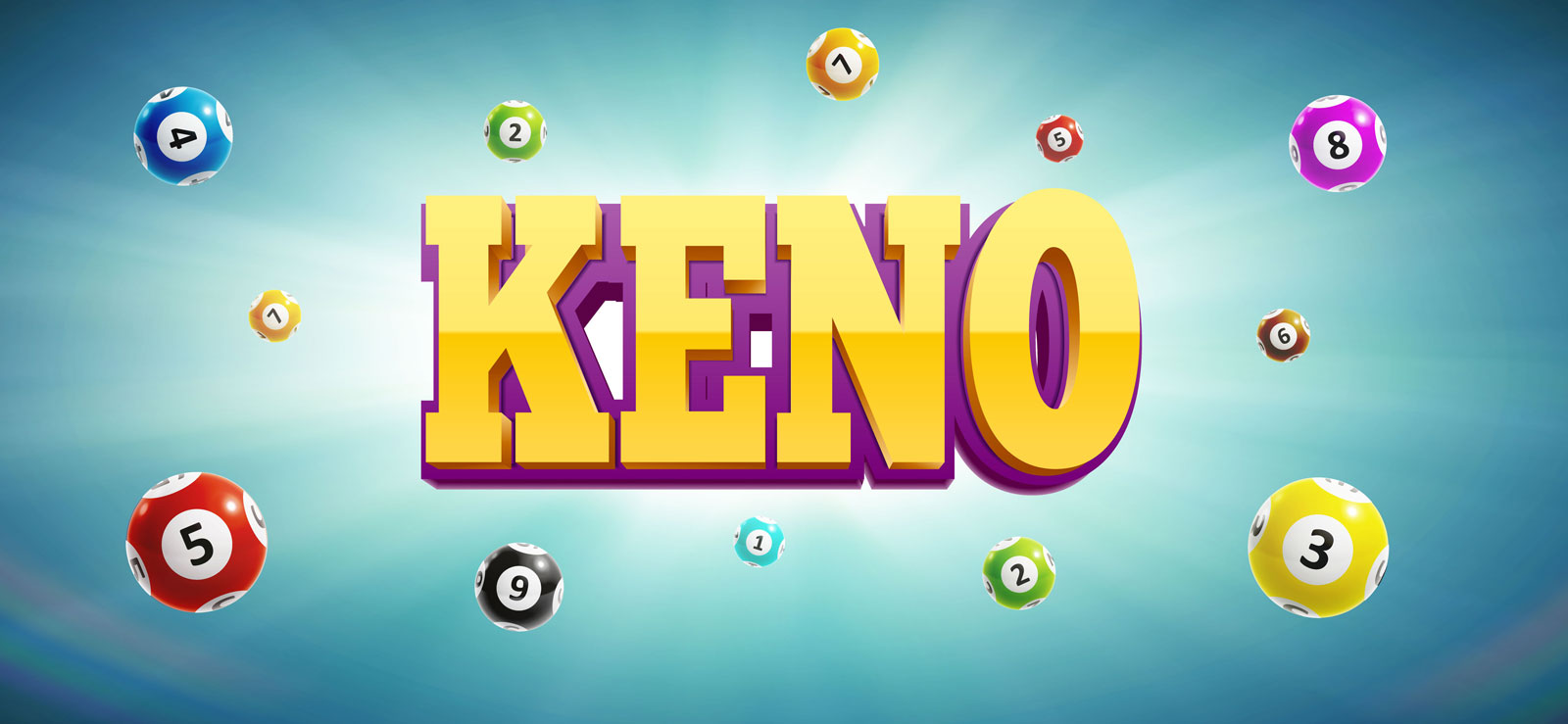How Does Keno Payout
Keno Prizes & Odds; Keno Past Numbers; Playing Keno is easy. Here are the four steps: Pick how many spots you want to play from 1 to 10. Pick how much you want to wager per draw ($1 to $10). Pick how many consecutive draws you want to play (1 to 20). To play KENO BONUS, mark the “Y” box on your bet slip. The cost of your wager will double. If you purchase the additional BONUS play for a drawing and win, you may multiply your winnings if a multiplier number (3, 4, 5 or 10) is drawn. The overall odds of having a multiplier number (3, 4, 5 or 10) are 1:2.3. The payouts for Keno differ from casino to casino, so ensure you look around to get the best payout if Keno is your game of choice. A standard payout structure is shown below (all amounts are payouts.
The prize tables in keno can look a bit complicated. Here’s our quick tips on what to look out for in keno pay schedules.
Each casino has its own system of payouts, which you will find set out in the Keno brochures or payout schedules around the casino or, if you’re playing Video keno you’ll find a payout table on each machine. An example is shown below.
The term ‘spot’ refers to how many numbers you have marked on your ticket. The term ‘catch’ refers to how many of your chosen numbers match what the house draws.
The table shows what you will win for a 1 coin stake. You need to multiply these amounts by the amount you are wagering. So in the example below, if you make a $2 bet, pick 4 spots and catch 3 of them you will win $12 (that is, $2 x 6).
This schedule does not pay out if you don’t match any numbers. But in some cases if you mark a lot of numbers the casino pays off if you catch 0.
Note that in Keno you do not get your stake back if you win.


Another Example of a Keno Paytable
This is the payout schedule for online casinos running on Microgaming software. If you like the look of it, here’s where to find Microgaming casinos.
In a live casino keno game, where lots of players are gambling on the same draw, the most the house can pay out for any one draw is generally $50,000. If there are too many winners they will each get a proportionate share of this sum.
Mass Lottery Keno Payouts
In this Article we Present to You an Extensive list of the Most Commonly Used Terminology in Keno!
Today, you can play keno both offline as well as online. If you are new to Keno, you would do well to know the different terms used in the game. What is an ‘all or nothing’? Or a ‘ball game’? What does someone mean when he uses the term ‘buy-in tournament’? This article provides a glossary of these and some other terms used in Keno.
The Most Important Keno Terms to Know
Keno: This is today’s version of an ancient Chinese lottery. You get to draw 20 numbers out of a total of 80 (nowadays the total is 120), and you win if you are able to correctly guess the numbers drawn.

All or Nothing: This is a term used in Keno to represent a ticket that pays only if you draw all the numbers picked, or if you draw none of the numbers picked.
Ball Game: This is the most common form of Keno nowadays. In this form of the game, plastic balls represent the numbers.
Blank: This is a term used to represent an unused Keno ticket.
Blower: The blower is part of the machine that is used to dispense the plastic balls used in Keno. With the blower, the game operator can force the balls into a tube, using air.
Buy-in Tournament: This is a type of Keno tournament where you have to pay a pre-determined fee upfront. Once you pay the fee, you are eligible to play in a specific number of games or play a set number of tickets. In a buy-in tournament, you get to keep any money you win.
Cage: The cage is no longer used in Keno games today. Basically, it was a wire cage used in the earlier days to hold Keno balls. Today, you mostly find plastic hoppers. The term ‘cage’ also denotes a specific area in a casino where only employees are allowed, and where you can find Keno workers.
Catch: This is a term used to denote a number that you have called in a Keno game.

Catch-all: This is a type of Keno game where you have to get all the numbers marked on your ticket. Another game is Catch-zero, where you must ensure you do not get any of the numbers that you have marked on your ticket.
Close: This is a term used to identify that period in time when the casino stops writing any more Keno tickets. The time period usually stretches from just prior to the draw till immediately after the draw.
Fractional Rate Ticket: This term is used to represent a ticket that you can play for a fraction of the standard rate.
Keno Payouts Charts
High End Ticket: This term is used to refer to a Keno ticket that pays you more if you catch a high number of spots. However, if you catch a lower number of spots compared to the standard ticket, you win less or even no money.
High Roller Ticket: This is a Keno ticket whose minimum pricing is high.

House Edge: This term is used to represent the percentage of bets that the house, i.e. the casino, can hope to win over time. The standard house edge is 30%, though this number is not necessarily the same for all casinos.
Las Vegas Keno Payout Table
Keno Glossary – Summing Up
Keno Odds And Payouts
The above are some of the terms that you will encounter when you start playing Keno. You would do well to read up more about the large number of terms related to Keno before going ahead and trying your luck at the game. We have further glossary lists on our site so check them out!